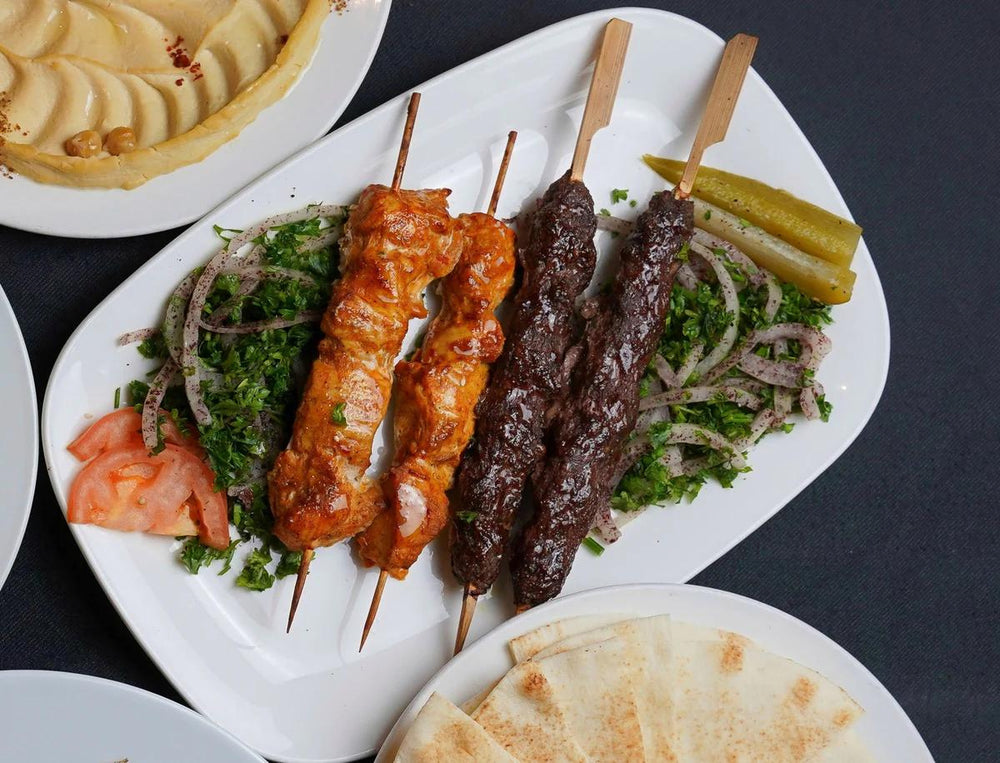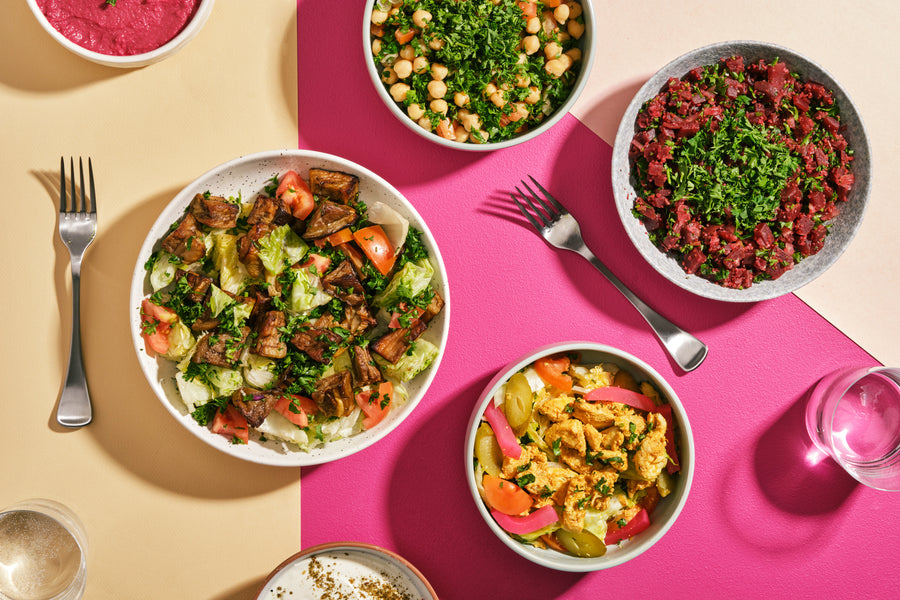Syrian Cuisine: A Halal Journey Through Flavor and Faith
Everything about the Rich Flavors and Traditions of Syrian Food: A Culinary Trip
Syrian cuisine uses a distinct blend of flavors and customs that show its rich cultural history. With staple components like olive oil and garlic, along with a variety of spices, the dishes are both varied and welcoming. From the elaborate preparation of kibbeh to the pleasant appeal of baklava, each element of this cooking landscape exposes deeper stories. As one explores the essence of these tastes, a better understanding of public dining and event arises.
The Essence of Syrian Active Ingredients
The significance of Syrian ingredients depends on their abundant variety and deep-rooted social importance. Influenced by the country's varied location and history, Syrian food incorporates a large variety of flavors, natural herbs, and fresh fruit and vegetables. Staples such as olive oil, garlic, and lemon supply a foundation, while spices like sumac, cumin, and coriander add depth and complexity to dishes.The use fresh herbs, consisting of parsley and mint, highlights the significance of seasonal components. Additionally, the region's fertile soil returns an abundance of veggies and fruits, such as pomegranates, eggplants, and tomatoes, which are indispensable to numerous dishes. Grains like bulgur and rice develop the base of many meals, underscoring the significance of these active ingredients in Syrian society. This blend of flavors shows not just a culinary tradition yet likewise a tapestry of historical impacts, making Syrian components necessary to recognizing its food's lively personality.

Iconic Dishes of Syrian Food
Syrian food is renowned for its iconic recipes that showcase a rich tapestry of appearances and flavors. Standard meze plates supply a range of little recipes that tantalize the palate, while hearty major programs supply enjoyable focal points for dishes (Afternoon Tea Vancouver). To finish the experience, a choice of savory desserts adds a wonderful note to the culinary journey
Traditional Meze Plates

Hearty Key Courses
Hearty major programs function as the focal point of Syrian dining, showcasing a mix of tastes that reflect the country's abundant culinary customs. Meals such as kebab hindi, including seasoned lamb skewers, and the renowned mujaddara, a reassuring mix of lentils and rice, highlight using aromatic flavors and fresh ingredients. An additional staple is the renowned kibbeh, made from bulgur wheat and minced meat, commonly offered in various types, consisting of baked, deep-fried, or raw. In addition, the tastes of the land come active in recipes like packed veggies, referred to as mahshi, which are loaded with rice, meat, and natural herbs. These main dishes not only satisfy cravings but also tell tales of family gatherings and social heritage.
Delicious Treats Choice
A fascinating selection of treats defines the wonderful side of Syrian food, supplying a tantalizing end to any kind of meal. Amongst one of the most renowned confections are baklava, delicate layers of phyllo pastry loaded with nuts and drenched in syrup, and maamoul, shortbread-like cookies often stuffed with nuts or days. Knafeh, an abundant dessert made from slim noodle-like bread saturated in syrup and split with cheese, is a popular choice, especially throughout festive occasions. In addition, the great smelling and sweet rice pudding, referred to as roz bil laban, supplies a comforting coating. These delightful treats not just showcase the region's cooking experience but additionally mirror the social heritage of Syria, making them treasured treats in both dining establishments and homes alike.
Typical Food Preparation Methods
Although contemporary conveniences have actually influenced lots of culinary practices, typical cooking methods stay important to Syrian food. These approaches frequently stress using fresh, seasonal components and focus on slow-moving cooking to create abundant tastes. Methods such as grilling, braising, and stewing are prevalent, allowing the natural preferences of the ingredients to shine through.One significant method is the prep work of kibbeh, a dish made from carefully ground meat and bulgur. It calls for skillful hand-rolling into numerous shapes and can be baked, fried, or served raw. Furthermore, the art of making bread, especially pita, is central to lots of meals, usually cooked in a traditional stone oven.Preservation methods like pickling and fermenting also play a vital role, improving the diversity of flavors discovered in Syrian meals. These methods not just reflect the region's agricultural heritage but additionally cultivate a strong sense of neighborhood with shared culinary methods.

The Role of Spices in Flavoring
Seasonings function as the heartbeat of Syrian cuisine, instilling recipes with complex flavors and fragrant deepness. Each flavor plays a crucial role, contributing not just to preference yet also to the cultural heritage of the area. Typically made use of seasonings consist of sumac, coriander, and cumin, each using a special profile that elevates standard dishes. For example, cumin gives heat and earthiness, while sumac includes a tangy illumination, enhancing the overall dish.Syrian chefs commonly blend seasonings to produce unified profiles, showing the complex equilibrium of flavors that specify the food. The usage of spices is not just for spices; it likewise offers to protect food and boost its dietary value. This thoughtful consolidation highlights a deep understanding of the cooking arts, where spices become crucial storytellers, sharing the rich background and diverse impacts that characterize Syrian gastronomy. Inevitably, flavors are essential in crafting genuine and memorable Syrian recipes.
Festive personalizeds and commemorative dishes
Celebratory dishes in Syrian food are marked by typical feast recipes that mirror the country's rich cooking heritage. Read More Here Special celebrations typically entail distinct routines that enhance the public experience of eating. These custom-mades not only honor the significance of the events yet likewise strengthen domestic and cultural bonds.
Traditional Feast Cuisines
When family members collect to celebrate considerable occasions in Syria, typical feast dishes take spotlight, showcasing the abundant cooking heritage of the region. These celebrations usually include dynamic platters of mezze, consisting of hummus, baba ghanoush, and tabbouleh, which work as wonderful starters. The primary program typically highlights lamb or hen, marinated and prepared to perfection, frequently gone along with by fragrant rice pilaf or bulgur. Among the most precious meals is maqlooba, a split rice meal with veggies and meat, flipped inverted before serving. Sweets also play an important duty, with baklava and knafeh offering a wonderful coating to the meal. Each dish not only thrills the taste but additionally reflects the deep-rooted customs and common spirit of Syrian culture.
Unique Event Rituals
Special occasions in Syria are noted by rich rituals that link food and celebration, reflecting the cultural importance of communal gatherings. Commemorative dishes typically include standard meals such as kibbeh, tabbouleh, and different grilled meats, prepared with care and shared amongst family members and pals. Throughout religious holidays like Eid al-Fitr and Eid al-Adha, family members integrated to prepare special sweets like maamoul, representing unity and joy. Wedding celebrations are particularly elaborate, featuring multiple training courses and dynamic display screens of hospitality. These events are not just concerning food; they encompass narration, dancing, and songs, reinforcing social bonds and social heritage. Through these rituals, Syrians commemorate life's milestones, guaranteeing practices are given via generations, enriching their culinary landscape.
The Value of Sharing and Neighborhood
Sharing dishes is an essential element of Syrian society, reflecting the ingrained values of community and link. In Syria, food is not just nutrition yet a means of bringing people together. Friends and families collect around the table to appreciate traditional meals, promoting bonds and producing lasting memories. This communal dining experience highlights hospitality, where hosts go to fantastic sizes to guarantee every visitor really feels welcomed and nourished.The act of sharing food also symbolizes generosity and uniformity, enhancing social connections within areas and larger neighborhoods. Throughout gatherings, it is typical for individuals to serve each various other, showcasing a spirit of togetherness that goes beyond uniqueness. Parties, whether tiny or large, are often marked by the sharing of meals, where diverse tastes and dishes integrated, reflecting the rich tapestry best site of Syrian culture. Appropriately, the value of sharing and neighborhood in Syrian food is not just a culinary tradition yet an important social technique.
A Culinary Exploration of Syrian Sweets
Typically overshadowed by tasty recipes, Syrian sweets hold a treasured location in the country's cooking heritage (Afternoon Tea Vancouver). These confections mirror the region's rich history, mixing flavors and strategies from numerous cultures. Standard desserts like baklava, with its layers of phyllo pastry, nuts, and honey syrup, showcase the artistry involved in Syrian cooking. Ma'amoul, a shortbread-like cookie full of nuts or days, is often gotten ready for cheery celebrations, signifying hospitality and celebration.Another cherished pleasant is Knafeh, a bread soaked in syrup and layered with cheese or lotion, using a fascinating contrast of appearances. Syrians also delight in a selection of fruit maintains and syrups, frequently offered with tea or as component of a larger spread during gatherings. These desserts find out here not only satisfy the taste however also act as a bridge in between generations, preserving the customs and stories of Syrian society through each savory bite
Regularly Asked Questions
What Are the Health Perks of Typical Syrian Foods?
The health and wellness advantages of conventional Syrian foods include rich nutrients from fresh veggies, legumes, and entire grains. These components advertise heart wellness, boost food digestion, and offer essential vitamins, adding to overall wellness and a balanced diet.
How Has Syrian Cuisine Developed Over the Years?
Syrian food has evolved considerably, influenced by historic trade courses, cultural exchanges, and regional accessibility of components. Standard recipes have actually incorporated modern-day tastes and strategies while preserving their abundant heritage, mirroring a diverse culinary landscape.
Exist Vegetarian or Vegan Options in Syrian Food?
Syrian food uses numerous vegan and vegan alternatives, including dishes like falafel, tabbouleh, and packed grape leaves. These dishes highlight the region's abundant farming heritage, showcasing fresh veggies, grains, and fragrant spices in dynamic combinations.
What Beverages Pair Well With Syrian Meals?
When thinking about beverages that complement Syrian dishes, one may locate that mint pomegranate, tea, and ayran juice improve the meal's tastes. Additionally, merlot usually sets well with the seasonings typically found in these foods.
Just How Can I Recreate Syrian Meals at Home?
To recreate Syrian dishes in your home, one ought to check out genuine recipes, collect standard active ingredients, and use cooking techniques one-of-a-kind to the cuisine. Experimenting with flavors and discussion additionally improves the general eating experience. Syrian cuisine is renowned for its renowned meals that showcase a rich tapestry of flavors and appearances. Spices offer as the heart beat of Syrian cuisine, instilling dishes with complicated tastes and aromatic deepness. Celebratory dishes in Syrian cuisine are noted by conventional feast dishes that reflect the nation's rich culinary heritage. Parties, whether big or tiny, are often marked by the sharing of dishes, where varied flavors and dishes come with each other, showing the rich tapestry of Syrian society. Syrian cuisine supplies numerous vegan and vegan alternatives, including dishes like falafel, tabbouleh, and packed grape fallen leaves.